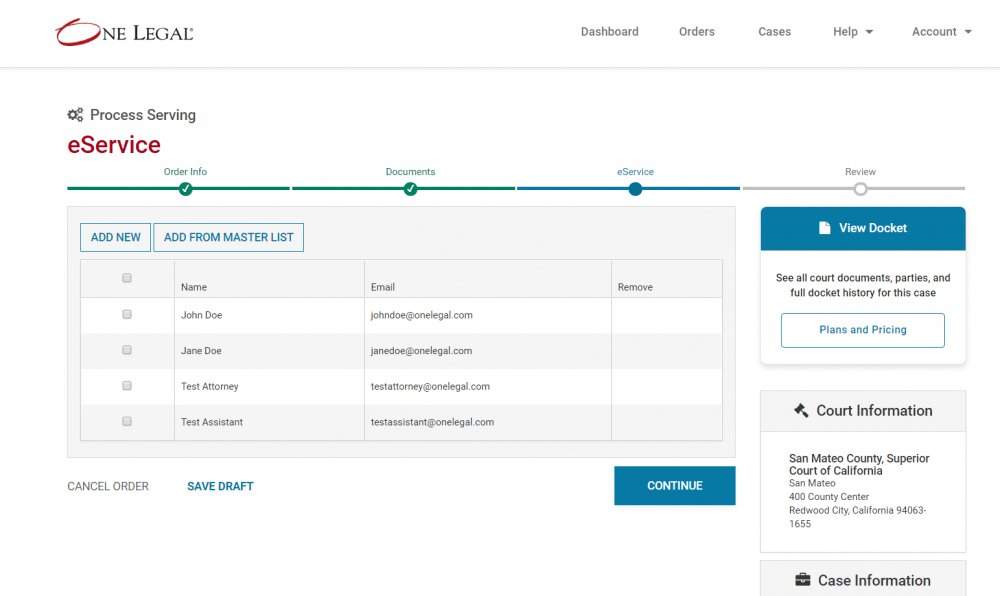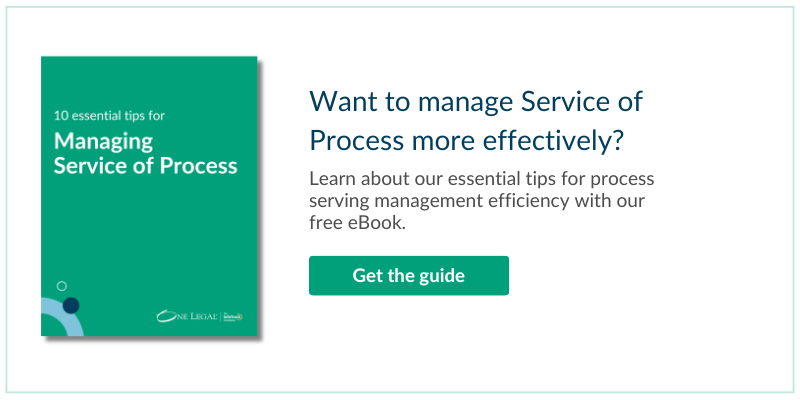Electronic service (eService) in California can often be tricky to get a handle on for legal professionals. At One Legal, we’ve been providing eService for almost two decades, so we have a pretty good idea of how it all works!
I’ve presented a number of webinars on eService over the years, including Service of Process 101: Personal service, eService, and more.
Over the years, our webinars have had great turnouts from professionals looking to learn more about eService in California, and I would like to point you in the direction of our Support Center for all the documentation you need.
While we’ve responded to as many queries in person as possible during our webinars and other interactions with clients, I wanted to share some of the most commonly asked questions and write them up here as a resource to help.
So, without further ado, here are our answers to the biggest questions that are asked about eService.
Who gets eServed?
A good starting point is to remember that eService in California is never used in case initiations, where each party in the case needs to be personally served.
eService is only ever used for subsequent filings, where parties are already aware of the ongoing case and the court already has jurisdiction over them.
Do the rules mandate that everyone in the firm that is on the service contact list be served or only the attorneys?
Typically, only counsel is required to be eServed. If the court has mandatory eFiling, then eService is mandatory (CRC 2.253) so consent is required.
You can learn more about consent here: CCP 1010.6(c)(3); and learn more about the 2019 changes to California state and local rules of court that are still applicable today.
If we are eServing the opposing attorney, do we also need to eServe the client they represent?
No, you do not, eServing the representation is sufficient.
I work in Probate where we have a lot of elderly clients that do not have email or computer access. How would it be possible for them to accept eService?
As their attorney, you may accept eService on their behalf.
Responding to an eServe
One of the more common questions we’ve got over the years is about the timelines given for responses, particularly when comparing service by mail to eService.
It’s important to remember that service by mail is another topic entirely, as CCP 415.30 authorizes a very limited form of service of complaint and summons by mail, with specific guidelines.
So, remember: eService is never used for service of complaint and summons.
In general, methods like faxing, mailing, or using FedEx that counsels might typically use in exchanging subsequently filed documents can be replaced by eService.
We still have to add two days for e-service, correct?
When being served by mail, parties have an additional five calendar days to respond, but with eService parties have an additional two court days (CCP 1010.6 B).
Code of Civil Procedure (CCP) 1010.6 (B)
The Code of Civil Procedure 1010.6 (B) outlines eService guidelines.
Electronic service of documents, governed by this section, defines “electronic service” as document delivery via electronic transmission or notification. It encompasses direct service by parties, agents, or courts.
Confidential records must be encrypted for secure electronic service, while mandatory electronic service may be ordered by the court for represented parties. Unrepresented individuals may consent to electronic service.
From July 1, 2024, courts must electronically transmit documents to parties subject to mandatory or consenting electronic service. Local rules may permit electronic filing, ensuring documents have legal validity.
Accessibility for disabled individuals and periodic legislative reporting on electronic filing systems are mandated, and vendors must ensure system compliance with accessibility guidelines and provide accommodations for disabilities.
Any period of notice, or any right or duty to do any act or make any response within any period or on a date after the service of the document, which the time period or date is prescribed by statute or rule of court, shall be extended after service via electronic means by two court days. Still, the extension shall not apply to extend the time for filing any of the following:
- A notice of intention to move for new trial.
- A notice of intention to move to vacate judgment under Section 663a.
- A notice of appeal.
Discovery
Discovery documents can be large and cumbersome, and hard to track using more traditional methods. eService can be used to help manage the process.
Can you use eService for discovery documents if they are not eFiled with the court?
Yes! Discovery along with correspondence. You can always place a standalone eService order using One Legal. Here is a link on How to order a standalone eService.
This option helps you to better track the receipt of the documents and improve the management of lengthy files.
Is discovery mandatory eService if the case is mandatory eFiling as well?
Yes, if eFiling is mandatory, then eService in California is mandatory. You can eServe discovery along with correspondence.
Learn more about how the benefits of eService go beyond email.
eService lists, email addresses, and more
Several queries we receive address the basic nuts and bolts of the eService process, starting with one common experience we’ve all encountered when emailing in general.
If an incorrect email address is provided to One Legal for eService purposes, how do we receive notification of the wrong email address? Is there any way of tracking that?
Your EFSP may not receive notifications from incorrect email addresses. If you used an email address that was provided to you, you still must do your due diligence. If you notice that the party you have eServed through One Legal doesn’t view the documents, you may want to test their email address from your own email client to see if you receive a notice of failure to send.
Is the eService list visible to everyone involved in the case? Or just for our view?
It is visible and will look the same to everyone using One Legal to eFile in that particular case. Here’s an example of One Legal’s platform for you.

If they are using another EFSP, it may look different. In addition, the court must make it available if requested; please see below.
Rule 2.251 (e) Maintenance of electronic service lists
A court that permits or requires electronic filing in a case must maintain and make available electronically to the parties and other persons in the case an electronic service list that contains the parties’ or other persons’ current electronic service addresses, as provided by the parties or other persons that have filed electronically in the case.
Is the Judicial Council considering the proper language to use when eService is made by the EFSP, instead of via email by the attorney/staff?
Remember: your EFSP doesn’t affect the service. The party or attorney does by either email (electronic transmission) or by using an EFSP (electronic notification).
In either case, the law firm has done the service and email; an EFSP is just the method used.
Proof of Electronic Service (POS-050)
For either of these methods, the Judicial Council form POS-050 works fine.
Proof of service for electronic service is governed by Code of Civil Procedure section 1013b.
Per Rule 2.251(j), proof of electronic service of must be filed at least five court days before the hearing.
If a person signs a printed form of a proof of electronic service, the party or person filing the proof must comply with the provisions of Rule 2.257(a).
This ensures that proper documentation is provided to demonstrate that electronic service has occurred in accordance with the rules and regulations outlined.
Compare to service by mail: If service is conducted by mail, the post office doesn’t provide proof of service; the party/attorney does.
Consent to eService
Without a doubt, questions focusing on consent to eService are the most frequent and we’ve had queries about some unique and challenging scenarios to address:
Is verbal confirmation between counsel/paralegals sufficient to implement eService within any case?
Not anymore. CCP 1010.6(a)(2), parties must serve notice on all parties and file the notice with the court, or the parties need to agree to the Terms of Service agreement from their EFSP. CCP 1010.6(c)(3).
Can an attorney rescind or refuse eService in a case that is mandatory eFiling?
If the court has mandatory eFiling, then eService is mandatory (CRC 2.253), so they do have to participate in eService. It’s only how they consent that has changed; the consent itself is still required.
In addition, a person who has provided express consent to accept service electronically may withdraw consent at any time by completing and filing with the court the appropriate Judicial Council form. EFS-006.
- A party or other person may manifest affirmative consent under (B) by:
- (A), serving a notice on all parties and other persons that the party or other person accepts electronic service and filing the notice with the court. The notice must include the electronic service address at which the party or other person agrees to accept service; or;
- (B) Manifesting affirmative consent through electronic means with the court or the court’s electronic filing service provider, and concurrently providing the party’s electronic service address with that consent for the purpose of receiving electronic service. A party or other person may manifest affirmative consent by serving notice of consent to all parties and other persons and either:
- (i) Agreeing to the terms of service with an electronic filing service provider, which clearly states that agreement constitutes consent to receive electronic service; or;
- (ii) Filing Consent to Electronic Service and Notice of Electronic Service Address (form EFS-005-CV).
Conclusion
We hope that this article has served as a useful resource for addressing some of the most common concerns and questions people have when eFiling in California.
Don’t forget to take a look at our Support Center for more information and guides that can help you understand all you need to know regarding eFiling.








